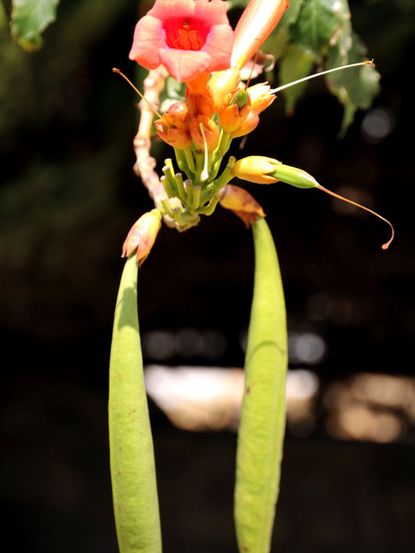Trumpet Vine Seed Pods: Tips For Germinating Trumpet Vine Seeds


Trumpet vine is a ferocious grower, often reaching 25 to 400 feet (7.5 - 120 m.) in length with a spread of 5 to 10 feet (1.5 cm. -3m.). It is a very hardy vine with vigorously flowering stems often used as a screen and ornamental backdrop. The vine forms seed pods after blooming, which resemble chubby little bean pods. What to do with these trumpet vine pods? You can try growing vines from seeds inside. Seed germination may be variable, so it is best to leave the pods on the vine until they are mature. Trumpet vine seed pods should be harvested three months after blooms have faded when they have turned from green to brown.
Seeds of Trumpet Vines
Those interesting looking pods on your Campsis vine have ornamental appeal and are full of seed to save and plant if you choose. Deciding what to do with trumpet vine pods depends upon your patience and adventurous levels. Leaving them on the plant for a fun visual effect is one option, but so is harvesting the seed and propagating more of the rampant vine. Be wary, the plant is considered too aggressive for some regions and may pose a problem if cultivation escapes into native flora areas. The curious gardener may just have to try growing the vine, however, so here are some tips on how to plant trumpet vine seeds for the best chances of success. Seeds are found inside the 2-inch (5 cm.) long pods that form after flowering. The seeds are flat, round brown discs with fine membranes that flare out from the edges. The seeds of trumpet vines may be planted at harvest or dried and stored for spring planting. Plants will take several years from seed to develop flowers. Harvest the pods when they are dry and brown. Use gloves when harvesting to prevent contact with the sap of the plant which can cause dermatological irritation. Crack pods open and spread the seed on a paper towel to dry for a week. Store seeds in an envelope in a glass lidded jar in the refrigerator until ready to sow. Trumpet vine seed pods left on the vine also provide interesting detail after the plant loses flowers and leaves.
Germinating Trumpet Vine Seeds
Germinating trumpet vine seeds is not the fastest way to get more plants. Campsis quickly propagates through root or sucker division and layering or cuttings. Seed germination seems to be more rapid when seeds undergo a chilling period of at least a couple of months. Soak seeds for 24 hours and then store them in bags filled with damp plant starter mix in the refrigerator for two months. In warmer climes, plant seeds right after harvest and drying, in containers outside where cool winter temperatures will provide the chilling period. In cooler regions, chill in the refrigerator and start outdoors after all danger of frost has passed or inside in flats 6 weeks before the date of the last freeze in your zone.
How to Plant Trumpet Vine Seeds
Use good garden soil amended with organic material or a purchased potting soil when planting seeds. Sow seed on the surface of the soil and lightly sprinkle more soil over them. Choose a well-draining container to prevent damping off and root rot as seeds germinate and sprout. As with any seeds, provide moderate water and place the flat or container in a warm area for quicker germination. To enhance germination, you can also cover the container with plastic wrap. Remove it once per day for an hour to allow excess moisture to evaporate. Fall planted seeds outdoors usually receive enough natural moisture unless your region is especially dry and should not be covered. Keep any weed pests away from seedlings as they grow. Transplant indoor plants in spring when soil temperatures have warmed to 60 degrees Fahrenheit (15 C.) or more.
Gardening tips, videos, info and more delivered right to your inbox!
Sign up for the Gardening Know How newsletter today and receive a free download of our most popular eBook "How to Grow Delicious Tomatoes."

Bonnie Grant is a professional landscaper with a Certification in Urban Gardening. She has been gardening and writing for 15 years. A former professional chef, she has a passion for edible landscaping.
-
 Grow a Bathroom Oasis: 8 Best Bathroom Plants With No Light or Low Light
Grow a Bathroom Oasis: 8 Best Bathroom Plants With No Light or Low LightSome apartment dwellers grow the best bathroom plants with no light or low light. Read how one of our favorite plant lovers does it in the big city.
By Teo Spengler
-
 "My Worst Mistake" – Gardeners Share 10 Hard-Learned Lessons
"My Worst Mistake" – Gardeners Share 10 Hard-Learned LessonsGardeners never stop learning, and sometimes our mistakes are the best teachers. But why not save time and heartache by learning from other gardeners' failures?
By Melanie Griffiths